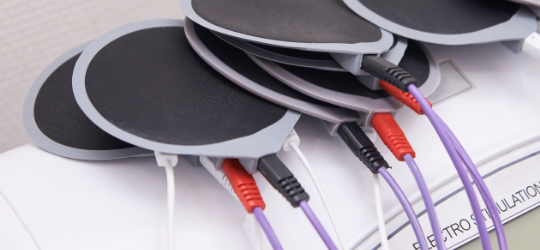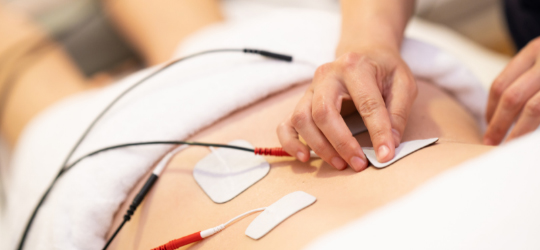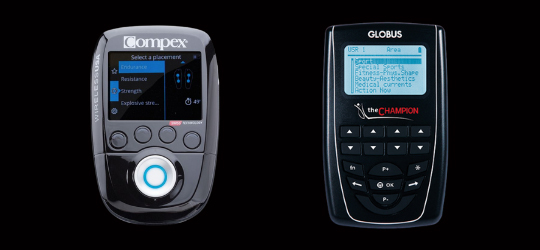The use of electric muscle stimulation (EMS) is widely used across a range of health and fitness disciplines, from physical therapy and rehab, to high-level, athletic performance.
Historically, the use of EMS for increasing performance in athletes has been more popular throughout Europe and other parts of the world than the US. The former Soviet Union, in particular, began extensive research into the practical application of EMS to improve performance as far back as the 1970s.
A variety of bold claims have been made about various EMS devices, including that they can:
- Increase muscle strength
- Stimulate muscle growth
- Improve explosive power
- Increase blood flow and circulation
- Decrease muscle soreness
- Prevent muscle wasting
- Enhance recovery
- Improve speed
- Accelerate rehabilitation
- Decrease pain
Before we get to the answer of whether or not EMS can actually do any of those things, it’s important to take a second to talk about how it works in the first place.
How does EMS work?

To understand EMS, you just have to know that your muscles contract via an electrical signal sent from the brain to your muscles through the nervous system.
EMS hijacks this process and sends an electrical signal through the skin to the muscles directly. This means they contract in much the same way, though not exactly identical to how nature does it.
Different kinds of EMS devices use different types of current, frequencies, amounts of power, and types of electrodes to make contact with the skin and cause the muscles to contract.
Clinical models used in physical therapy clinics can be several thousands of dollars. On the other side, you can find small, low power models for as little as $50 at mall kiosks and retail stores.
In short, all EMS units are not created equal and this is an extremely important thing to be aware of.
What about TENS?
Aside from EMS devices, you may have heard about TENS. Both TENS (transcutaneous electrical nerve stimulation) and EMS use electrical currents through the skin, but EMS uses a stronger current to stimulate muscle contractions.
TENS, on the other hand, targets specific nerves to reduce pain signaling to the brain. It’s most commonly used in physical therapy, surgical recovery, and rehab.
While both TENS and EMS can stimulate nerves to help relieve pain, EMS is what’s most often used in the realm of fitness and performance.

Does EMS work?
The most accurate answer to whether or not EMS works and is worth using is that it depends.
This is because first of all, there is a wide range of EMS devices out there. Some can be extremely effective, while others are little more than a gimmick.
Expect to pay a fairly high price to get a good EMS system. If you do want to use EMS in your program, my two brand recommendations are Compex and Globus.
Compex has a broad selection of devices that are designed to be user friendly. Their wireless models also eliminate the traditional issue of having to be connected directly to the power units.
Due to FDA regulations, you’ll find the selection of Compex units available on the USA website far more limited than in many other countries. Many of their high end models are not available to order directly, so you may have to get a bit creative if you’d like to get your hands on one.

Globus, on the other hand, is a less well-known brand from Italy that’s also branched out into athletic performance. They have a range of models aimed at different sports and their prices tend to be on the higher end.
Overall, their devices are not as user-friendly, and they lack a wireless option. That said, they also offer a wider range of options and programs in their devices and they’re also some of the most powerful available outside of the medical industry.
Can EMS speed up your recovery?
How effective a good EMS system is at improving recovery depends on what you’re comparing it against. Compared to being inactive and doing nothing in between workouts, using EMS can have a noticeable benefit.
Compared to incorporating things like recovery workouts, regeneration strategies, and activities that require movement, research suggests that by itself, EMS is generally not as effective.
Stimulating muscles with electric current is better than not simulating them at all and can have benefits, but it’s not really the same as doing it the old fashion way.
Where EMS can be extremely effective is for returning after an injury.
It allows you to get blood and fluids into tissues surrounding the injury, while stimulating the nervous system to active muscles that may have been inactive during the healing process.

Overall, EMS is probably the most beneficial for people that would otherwise not do anything active for recovery. If you’re not going to incorporate recovery workouts and get in a good amount of overall activity each day, then 15-20 minutes of EMS is a good alternative.
It’s also beneficial if you’re constantly traveling and/or dealing with injuries that prevent you from training consistently. Here, adding in EMS can speed up your rehab time and help you get in some additional muscle activation when you can’t get to the gym.
Finally, there’s no reason you can’t use some EMS as part of your training itself. It can be used pre-workout as part of your warm up, for example. Some models even make it possible to do various exercises at the same time with EMS on.
So while EMS is not a replacement for moving or training, it can still be a valuable tool when used for the right purposes and with the right expectations.
Action step
If you’re going to buy an EMS system, make sure to do your homework. It’s much better to invest in a high-quality system than buy one that’s inexpensive, but also ineffective.
